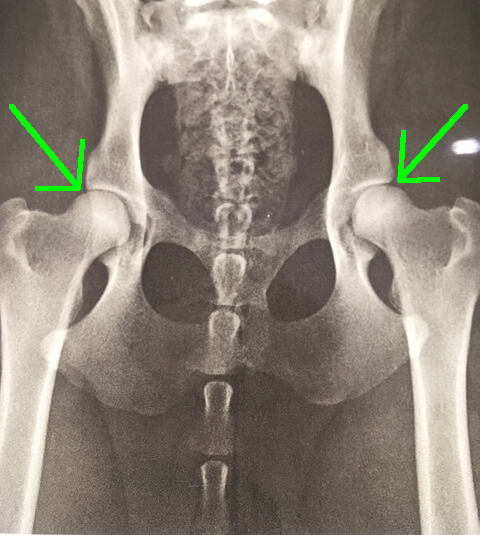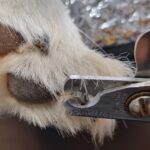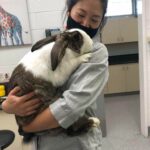We usually think of arthritis as an “old dog” disease – and it usually does tend to affect our pets as they get older. But there are some conditions that can happen in younger dogs which can lead to early-onset joint disease, and knowing if your pet is at risk is the first step to managing their discomfort.
Hip dysplasia is a condition in dogs caused by abnormal formation of the hip joint. In a healthy dog, the joint acts like a “ball and socket” – the round end of the femur (thigh bone) fits neatly into the socket formed by the hip bone. In a dog with hip dysplasia, the hip socket is too shallow for the end of the femur to fit properly, and the bones move in abnormal ways with each other. Since the joint is unstable, this can lead to painful changes in the hip – formation of osteophytes (abnormal bone spurs in and around the joint), dislocation of the hip joint, abnormal thickening of the end of the femur, and thickening of the capsule that surrounds the hip joint. These changes cause the hips to be much harder and more painful to move normally.
A puppy with hip dysplasia may not show any obvious signs such as limping or pain, but as the pup grows into an adult, the joint starts to degenerate and signs of arthritis develop. These pups may not play as much or for as long as their healthy siblings, and they may even have trouble jumping or running easily. Many of dogs with hip dysplasia will show a classic gait called a “bunny hop”. This is where they bound along with both back legs, instead of extending each one individually. This movement takes the pressure of each hip joint and powers them along with the lower part of the leg.
A normal hip joint looks like this: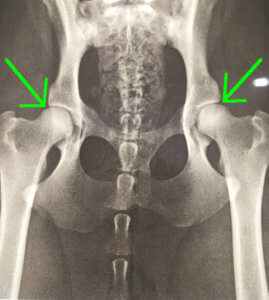 The green arrows show where the hip joint sits. This image shows a femur that fits neatly into the hip bone, with no laxity or joint disease.
The green arrows show where the hip joint sits. This image shows a femur that fits neatly into the hip bone, with no laxity or joint disease.
This image shows a dog with hip dysplasia: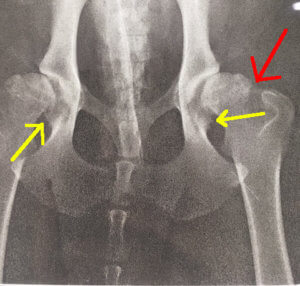 The socket of the hip is too shallow for the end of the femur, so the joint is not stable. There is also some early thickening (red arrow) of the end of the femur and some osteophytes forming (yellow arrows) in the hip bone.
The socket of the hip is too shallow for the end of the femur, so the joint is not stable. There is also some early thickening (red arrow) of the end of the femur and some osteophytes forming (yellow arrows) in the hip bone.
This image shows a dog with severe complications of hip dysplasia: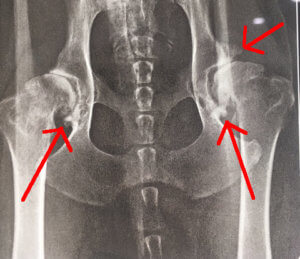 The shape of the femur and hip socket have been completely distorted by abnormal bone growth. Movement in this joint will cause the abnormal bone to grind on itself and be extremely painful.
The shape of the femur and hip socket have been completely distorted by abnormal bone growth. Movement in this joint will cause the abnormal bone to grind on itself and be extremely painful.
Hip dysplasia is a genetic condition usually passed down to puppies by their parents. Other environmental factors such as obesity and rapid growth can also have some influence on how quickly the abnormal joint degenerates. It is by far more common in large and giant breed dogs such as German Shepherds, Rottweilers, Golden Retrievers, Labradors, Bulldogs and Great Danes, but can affect any breed, both small and large. All large breed dogs should be screened for hip dysplasia. Those with abnormal hips should not be bred with.

